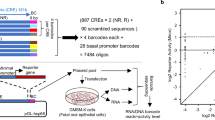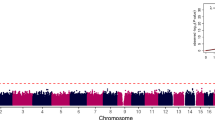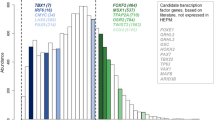Abstract
Cleft lip with or without cleft palate is the most frequent craniofacial malformation in humans (∼1/700). Its etiology is multifactorial; some are a result of a genetic mutation, while others may be due to environmental factors, with genetic predisposition playing an important role. The prevalence varies widely between populations and the mode of inheritance remains controversial. The interferon regulatory factor-6 (IRF6) gene has been shown to harbor mutations in patients with van der Woude syndrome, a dominant form of clefts associated with small pits of the lower lip. Moreover IRF6 has been associated with nonsyndromic cleft of the palate (CL/P) in two separate studies. We investigated the role of IRF6 in a set of 195 trios from Belgium. Cleft occurred as an isolated feature. We studied association of the IRF6 locus using two variants: one in the IRF6 gene and the other 100 kpb 3′ of the gene. Our independent study group confirms that the IRF6 locus is associated with nonsyndromic cleft lip with or without palate. This result, with previous studies performed in the United States and Italy, shows for the first time the implication of IRF6 in isolated CL/P in northern Europe. It is likely that association to this locus can be identified in various populations and that the IRF6 locus thus represents an important genetic modifier for this multifactorial malformation.
Similar content being viewed by others
Log in or create a free account to read this content
Gain free access to this article, as well as selected content from this journal and more on nature.com
or
References
Murray JC, Schutte BC : Cleft palate: players, pathways, and pursuits. J Clin Invest 2004; 113: 1676–1678.
Van den Boogaard MJ, Dorland M, Beemer FA, van Amstel HK : MSX1 mutation is associated with orofacial clefting and tooth agenesis in humans. Nat Genet 2000; 24: 342–343.
FitzPatrick DR, Carr IM, McLaren L et al: Identification of SATB2 as the cleft palate gene on 2q32–q33. Hum Mol Genet 2003; 12: 2491–2501.
Loeys BL, Chen J, Neptune ER et al: A syndrome of altered cardiovascular, craniofacial, neurocognitive and skeletal development caused by mutations in TGFBR1 or TGFBR2. Nat Genet 2005; 37: 275–281.
Murray JC : Gene/environment causes of cleft lip and/or palate. Clin Genet 2002; 61: 248–256.
Jones MC : Etiology of facial clefts: prospective evaluation of 428 patients. Cleft Palate J 1988; 25: 16–20.
Schutte BC, Murray JC : The many faces and factors of orofacial clefts. Hum Mol Genet 1999; 8: 1853–1859.
Van der Woude A : Fistula labii inferioris congenita and its association with cleft lip and palate. Am J Hum Genet 1954; 6: 244–256.
Lacombe D, Pedespan JM, Fontan D : Phenotypic variability in van der Woude syndrome. Genet Counsel 1995; 6: 221–226.
Houdayer C, Soupre V, Rosenberg-Bourgin M et al: Linkage analysis of 5 novel van der Woude kindreds to 1q32–q41 markers further supports locus homogeneity of the disease trait. Ann Genet 1999; 42: 69–74.
Kondo S, Schutte BC, Richardson RJ et al: Mutations in IRF6 cause van der Woude and popliteal pterygium syndromes. Nat Genet 2002; 32: 285–289.
Ghassibe M, Revencu N, Bayet B et al: Six families with van der Woude and/or popliteal pterygium syndrome: all with a mutation in the IRF6 gene. J Med Genet 2004; 41: e15.
Zucchero TM, Cooper ME, Maher BS et al: Interferon regulatory factor 6 (IRF6) gene variants and the risk of isolated cleft lip or palate. N Engl J Med 2004; 351: 769–780.
Scapoli L, Palmieri A, Martinelli M et al: Strong evidence of linkage disequilibrium between polymorphisms at the IRF6 locus and nonsyndromic cleft lip with or without cleft palate, in an Italian population. Am J Hum Genet 2005; 76: 180–183.
Spielman RS, McGinnis RE, Ewens WJ : Transmission test for linkage disequilibrium: the insulin gene region and insulin dependent diabetes mellitus (IDDM). Am J Hum Genet 1993; 52: 506–516.
Daly MJ, Kruglyak L, Pratt S et al: Genehunter Documentation, version 2.0 beta 1998, http://linkage.rockefeller.edu/soft/gh/index.html.
Horvath S, Xu X, Laird NM : The family based association test method: strategies for studying general genotype–phenotype associations. Eur J Hum Genet 2001; 9: 301–306.
Laird NM, Horvath S, Xu X : Implementing a unified approach to family-based tests of association. Genet Epidemiol 2000; 19 (Suppl 1): S36–S42.
Access to FBAT and HaploFBAT at http://www.biostat.harvard.edu/~fbat/default.html.
Abecasis GR, Cookson WO : GOLD – graphical overview of linkage disequilibrium. Bioinformatics 2000; 16: 182–183.
Stanier P, Forbes SA, Arnason A et al: The localization of a gene causing X-linked cleft palate and ankyloglossia (CPX) in an Icelandic kindred is between DXS326 and DXYS1X. Genomics 1993; 17: 549–555.
Van den Boogaard MJ, Dorland M, Beemer FA, van Amstel HK : MSX1 mutation is associated with orofacial clefting and tooth agenesis in humans. Nat Genet 2000; 24: 342–343.
Celli J, Duijf P, Hamel BC et al: Heterozygous germline mutations in the p53 homolog p63 are the cause of EEC syndrome. Cell 1999; 99: 143–153.
Dode C, Levilliers J, Dupont JM et al: Loss-of-function mutations in FGFR1 cause autosomal dominant Kallmann syndrome. Nat Genet 2003; 33: 463–465.
Loeys BL, Chen J, Neptune ER et al: A syndrome of altered cardiovascular, craniofacial, neurocognitive and skeletal development caused by mutations in TGFBR1 or TGFBR2. Nat Genet 2005; 37: 275–281.
Acknowledgements
We thank Jeffrey C Murray and Theresa Zucchero for providing us with SNP materials and for help with study design. We are grateful for all the families for their participation in the study. The studies were supported by the Fonds Spéciaux de Recherche – University of Louvain Medical School, the Fonds national de la recherche scientifique (FNRS) (to MV, a ‘maître de recherche du FNRS’). M Ghassibé was supported by a fellowship from FRIA (Fonds pour la formation à la recherche dans l’industrie et dans l’agriculture).
Author information
Authors and Affiliations
Corresponding author
Rights and permissions
About this article
Cite this article
Ghassibé, M., Bayet, B., Revencu, N. et al. Interferon regulatory factor-6: a gene predisposing to isolated cleft lip with or without cleft palate in the Belgian population. Eur J Hum Genet 13, 1239–1242 (2005). https://doi.org/10.1038/sj.ejhg.5201486
Received:
Revised:
Accepted:
Published:
Issue date:
DOI: https://doi.org/10.1038/sj.ejhg.5201486
Keywords
This article is cited by
-
Knockdown of Crispld2 in zebrafish identifies a novel network for nonsyndromic cleft lip with or without cleft palate candidate genes
European Journal of Human Genetics (2018)
-
Sequencing of the interferon regulatory factor 6 (IRF6) gene and correlation to its phenotypes in familial non-syndromic cleft lip and palate in North Indian population
European Journal of Plastic Surgery (2014)
-
A combined targeted mutation analysis of IRF6 gene would be useful in the first screening of oral facial clefts
BMC Medical Genetics (2013)
-
Cleft lip and palate: understanding genetic and environmental influences
Nature Reviews Genetics (2011)
-
Evidence of gene–environment interaction for the IRF6 gene and maternal multivitamin supplementation in controlling the risk of cleft lip with/without cleft palate
Human Genetics (2010)



